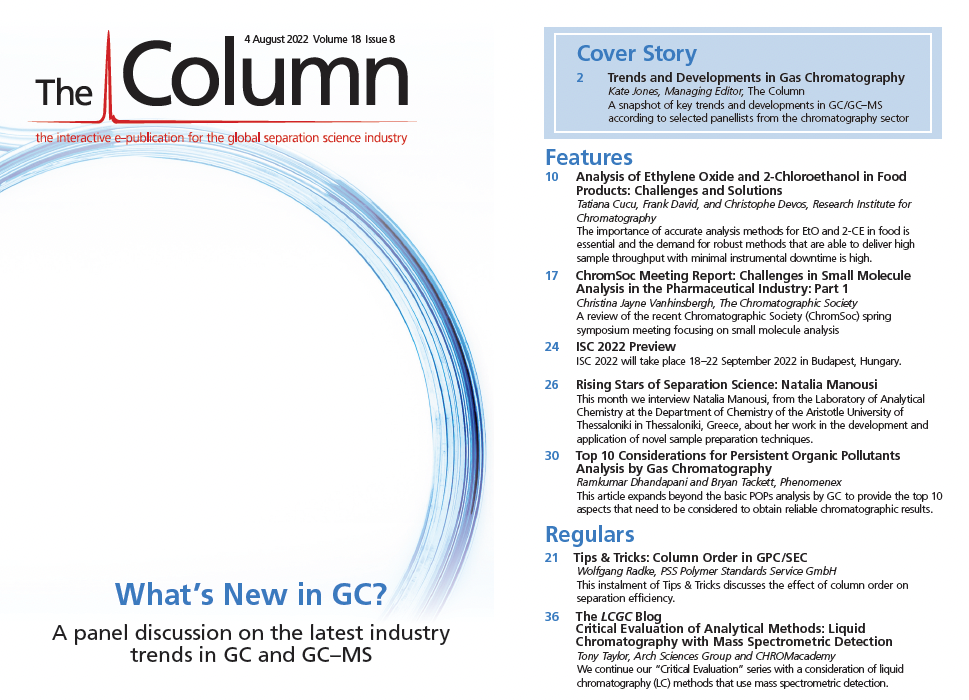Rising Stars of Separation Science: Natalia Manousi
This month we interview Natalia Manousi, from the Laboratory of Analytical Chemistry at the Department of Chemistry of the Aristotle University of Thessaloniki in Thessaloniki, Greece, about her work in the development and application of novel sample preparation techniques, and the difficulties involved in developing green sample preparation techniques.
Q. When did you first encounter chromatography?
A: I first encountered chromatography during my B.Sc. diploma thesis. During this, we aimed to develop a direct ultrahigh-pressure liquid chromatography–diode array detection (UHPLC–DAD) method for the determination of antipsychotics and antidepressant drugs in different biological fluids. Since then, I have continued to apply chromatographic techniques in the development of analytical methods for the determination of a wide range of organic compounds in biological, food, and environmental samples. In the meantime, I have also expanded my research interests in the determination of inorganic species—including nutrient and toxic metals, as well as rare earth elements using spectroscopic techniques.
Q. Can you tell us more about your Ph.D. thesis?
A: My Ph.D. thesis was about the development of green sample preparation techniques based on novel materials for the determination of environmental pollutants in food and environmental samples. I worked on it in the Laboratory of Analytical Chemistry in the School of Chemistry of Aristotle University of Thessaloniki (AUTH) in Greece, under the supervision of George Zachariadis. During my Ph.D. thesis, I have worked with different modern sample preparation techniques, including fabric phase sorptive extraction (FPSE), capsule phase microextraction (CPME), magnet integrated fabric phase sorptive extraction (MI-FPSE), dispersive solid-phase extraction (d-SPE), and magnetic solid-phase extraction (MSPE). Polycyclic aromatic hydrocarbons (PAHs) and pesticides, as well as inorganic pollutants, were the main target analytes that we aimed to determine in a variety of food and environmental samples. Moreover, I worked on the evaluation of the applicability of novel extraction materials (that is, sol-gel sorbents, graphene oxide derivatives) to improve extraction efficiency and selectivity. The main goal was to find more sustainable alternatives to conventional sample preparation techniques, while also maintaining the fundamental advantages of well-established techniques.
Q. What chromatographic techniques have you worked with?
A: During my academic and professional career as an analytical chemist, I have worked with high performance liquid chromatography (HPLC–UV, HPLC–DAD, HPLC–fluorescence detection [FLD], HPLC–evaporative light scattering detection [ELSD], HPLC–mass spectrometry [MS]) and gas chromatography (GC–flame ionization detection [FID], GC–electron capture detector [ECD], GC–MS). I enjoy working with both chromatographic techniques; I cannot say that I prefer working with one over the other.
Q. Your primary research focus is the development and application of novel sample preparation techniques—what specifically attracted you to this area of research?
A: Sample preparation is undoubtedly one of the most polluting steps during the analytical procedure. The development and application of more sustainable sample preparation techniques is therefore an important step towards compliance with the principles of green analytical chemistry (GAC) (1). Currently, there is a plethora of novel microextraction and miniaturized-based extraction techniques (solid‑phase microextraction [SPME], liquid‑phase microextraction [LPME], FPSE, CPME, MSPE, d-SPE), as well as a wide range of novel extraction materials (carbon nanotubes, graphene oxide, molecularly imprinted polymers, metal-organic frameworks, covalent organic frameworks), with advanced efficiency towards the extraction of the target analytes. Thus, the evaluation of different combinations of extraction techniques and extraction sorbents and the development of novel protocols is a highly interesting scientific field being investigated.
Q. Can you talk a little about the difficulty of developing green sample preparation techniques?
A: Although there is currently a great effort involved in the development of green sample preparation techniques from a plethora of research groups worldwide, their application in “real-life” experiments is currently limited and not a lot of them find wide acceptance from the scientific community. A possible explanation of this phenomenon is that although we try to meet the green aspects that emerge from GAC, the analytical characteristics and the practical considerations of these methods are sometimes neglected. A holistic view that considers the green character of a method along with practicability issues (cost and speed) and its analytical efficiency (sensitivity, accuracy, and precision) was recently introduced and described as white analytical chemistry (WAC) (2). Therefore, the great challenge towards the development of novel sample preparation techniques is to meet the terms of WAC and to provide a compromise between its individual components.
Q. You have recently published a paper applying a novel magnetic graphene oxide nanocomposite modified with polyaniline (Fe3O4@GO-PANI) for the extraction of polycyclic aromatic hydrocarbons (PAHs) and nitrated polycyclic aromatic hydrocarbons (N-PAHs) (3). Could you tell us more about this research project?
A: PAHs and N-PAHs are harmful chemical compounds that are associated with carcinogenic, mutagenic, and teratogenic activity. Therefore, the determination of these compounds in environmental matrices at low concentrations is of high importance. Among the different extraction and preconcentration techniques, MSPE is an interesting alternative to conventional sample preparation approaches because it exhibits handling simplicity and reduced organic solvent consumption. In MSPE, a magnetic sorbent is directly added to the sample, and it can be easily removed with the assistance of an external magnetic field. Currently, there is an ongoing trend in analytical chemistry towards the development of novel extraction materials with increased efficiency and selectivity. In the aforementioned work, we developed a magnetic graphene oxide nanocomposite modified with polyaniline (PANI) in collaboration with the group of Eleni Deliyanni. PANI contains a good deal of π-conjugated structures, increasing the adsorption efficiency of graphene oxide. The proposed sorbent was characterized and used for the extraction of the target analytes from water samples prior to their determination by GC–MS. The method showed good performance characteristics and it was successfully employed for the analysis of river, mineral, and tap water samples (3).
Q. Why is this research important and what advantages could it offer over existing techniques?
A: In this research it was confirmed that MSPE, a miniaturized form of solid-phase extraction, can be a powerful alternative to conventional sample preparation approaches for the extraction of PAHs. Miniaturized extraction approaches are associated with multiple benefits, including “greenness” and ease in handling. Moreover, it was clearly proved that the utilization of advanced sorbents can result in analytical techniques with good figures of merit (that is, accuracy, precision, linearity, sensitivity, and selectivity). These materials can be easily synthesized in any laboratory. Thus, we consider this as an encouraging step towards the synthesis and application of novel extraction materials in sample preparation.
Q. Are there any challenges involved with using this sorbent? Could it be used for any other applications?
A: Due to the two-dimensional plane structure of graphene oxide and the π-stacking property of graphene oxide nanosheets, this material exhibits high sorption capacity, and it is considered to be an excellent sorbent for solid-phase extraction. The preparation of magnetic nanocomposites combines the benefits of the extraction efficiency of graphene oxide and the ease of separation of magnetic materials. Moreover, the functionalization with polymeric materials can result in a composite material with good dispersibility and can prevent the potential aggregation of graphene nanosheets. The applicability of Fe3O4@GO-PANI could be potentially expanded for the adsorption of a wide range of organic molecules (drugs, environmental pollutants, endocrine-disrupting compounds). At the same time, this material could serve as a powerful adsorbent for environmental remediation, and it could be used for the removal of organic and inorganic pollutants.
Q. Another of your recent papers discusses capsule phase microextraction (CPME) and its first employment in the extraction of four PAHs from water samples prior to GC–MS analysis (4). What is CPME? What is novel about this research and what advantages does it offer the analyst?
A: CPME is a recently introduced microextraction technique developed by Abuzar Kabir and Kenneth G. Furton from Florida International University. This sample preparation technique utilizes in situ prepared monolithic sol-gel sorbents encapsulated in porous polypropylene microextraction capsules (5).
In the aforementioned work, microextraction capsules containing sol-gel poly(caprolactone)-poly(dimethylsiloxane)-poly(caprolactone) (PCAP-PDMS-PCAP) sorbent were employed for the extraction of naphthalene, fluorene, phenanthrene, and pyrene from water samples prior to their determination by GC–MS. Good performance characteristics and sorbent reusability were demonstrated, and the proposed protocol was successfully implemented for the analysis of tap water, mineral water, and lake water samples (4).
CPME enjoys the enormous advantages of the sol-gel synthesis process that assure very high thermal, solvent, and chemical stability of the sorptive phase, as well as unprecedented batch-to-batch reproducibility. Due to the inherent porosity of the CPME capsules, this technique can be employed for the direct analysis of samples that contain particulates, debris, and insoluble matrix interferents, without any requirement for sample filtration. Moreover, back-extraction can take place in specially designed low volume vials, thus eliminating the need for evaporation and reconstitution of the sample in lower volumes. CPME can overcome the need for error-prone steps during sample preparation, increasing the speed and the sample throughput. At the same time, low quantities of organic solvents are consumed in accordance with the principles of GAC.
Q. What projects are you working on next?
A: I will certainly continue working on developing novel sample preparation protocols that meet the terms of GAC and WAC in the research group of my Ph.D. supervisor and in collaboration with other research groups. Currently, we are focused on developing microextraction protocols for compounds of bioanalytical interest in collaboration with the research group of Constantinos Zacharis in the Laboratory of Pharmaceutical Analysis at the School of Pharmacy of AUTH. Moreover, my future steps also include the development of online automated sample preparation protocols aimed at reducing human intervention during sample analysis. Thus, in collaboration with Aristidis Anthemidis’ group in the Laboratory of Analytical Chemistry at the Department of Chemistry of AUTH, we have started to work on coupling novel extraction materials with online automated techniques for the monitoring of environmental pollutants in food, environmental, and biological samples. Another future project that we aim to investigate is the evaluation of novel sample preparation techniques for untargeted analysis to explore the volatile metabolome of complex food samples for authenticity studies in a collaboration with Natasa Kalogiouri.
Q. What are the emerging trends in sample preparation?
A: Emerging trends in sample preparation revolve around the development of sustainable and environmentally friendly techniques. Greening sample preparation is an important step towards the elimination of organic solvent consumption and waste generation. At the same time, it is important to promote automation that could result in operational simplicity, enhanced sample throughput, reduction of errors, and reduced operator exposure to hazardous reagents.
Q. Have you any advice for younger scientists entering the field of chromatography?
A: Just some advice to every young scientist that I was also given, and I follow every day: Take as many opportunities as possible and work in different areas to broaden your horizons. Do not be scared to change working environments and try to visit as many laboratories as you can. Exchanges in other cities/countries are the best way to meet other researchers and to come in contact with other subdisciplines of analytical chemistry.
I would also like to thank my Ph.D supervisor George Zachariadis for all his support, and also Erwin Rosenberg from Vienna University of Technology and Yolanda Madrid from Complutense University of Madrid for giving me the opportunity to work in their groups during my Ph.D. thesis. Finally, I would like to thank Aristidis Anthemidis, Eleni Deliyanni, Abuzar Kabir, Constantinos Zacharis, and Natasa Kalogiouri for our ongoing collaboration.
References
- A. Gałuszka, Z. Migaszewski, and J. Namieśnik, TRAC-Trend. Anal. Chem. 50, 78–84 (2013).
- P. Nowak, R. Wietecha-Posłuszny, and Janusz Pawliszyn, TRAC-Trend. Anal. Chem. 138, 116223 (2021).
- N. Manousi, E.A. Deliyanni, E. Rosenberg, and G.A. Zachariadis, J. Chrom. A 1645(46), 462104 (2021).
- N. Manousi, A. Kabir, K.G. Furton, E. Rosenberg, and G.A. Zachariadis, Microchem. J. 166(6), 106210 (2021).
- A.F. Kabir and K.G. Furton, U.S. patent 2017/0023452A1, 26 January 2017.

Natalia Manousi defended her Ph.D. thesis in 2022 in the Laboratory of Analytical Chemistry at the Department of Chemistry of the Aristotle University of Thessaloniki in Thessaloniki, Greece. She received her B.Sc. in chemistry (2015) from the Aristotle University of Thessaloniki and her M.Sc. in analytical chemistry and quality control (2017) from the National and Kapodistrian University of Athens supported by the Onassis Foundation Scholarship. She performed her M.Sc. thesis in the Institute of Chemistry at University of Graz (Austria) under the framework of the Go Styria research scholarship. She started her Ph.D. in 2018 under the supervision of George Zachariadis and her research work was supported by the Hellenic Foundation for Research and Innovation (HFRI). Her Ph.D. topic was on the development of green sample preparation techniques based on novel materials for the determination of environmental pollutants in food and in environmental samples. During her Ph.D., she worked in the Department of Analytical Chemistry at the Faculty of Chemistry in University Complutense University of Madrid (Spain) in the research group of Yolanda Madrid, supported by an Utrecht Network Young Researchers Grant, and in the Institute of Chemical Technologies and Analytics at Vienna University of Technology (Austria) in the research group ofErwin Rosenberg, supported by an Erasmus + Studies Grant. She was included in the Next Great Impossible Project organized by Sigma-Aldrich and the Female Talent Project organized by the European Central Bank. She has been a member of the organizing and scientific committee of more than 10 scientific conferences, and she has authored over 55 peer-reviewed contributions including articles and book chapters.

Thermodynamic Insights into Organic Solvent Extraction for Chemical Analysis of Medical Devices
April 16th 2025A new study, published by a researcher from Chemical Characterization Solutions in Minnesota, explored a new approach for sample preparation for the chemical characterization of medical devices.
Common Challenges in Nitrosamine Analysis: An LCGC International Peer Exchange
April 15th 2025A recent roundtable discussion featuring Aloka Srinivasan of Raaha, Mayank Bhanti of the United States Pharmacopeia (USP), and Amber Burch of Purisys discussed the challenges surrounding nitrosamine analysis in pharmaceuticals.
Silvia Radenkovic on Building Connections in the Scientific Community
April 11th 2025In the second part of our conversation with Silvia Radenkovic, she shares insights into her involvement in scientific organizations and offers advice for young scientists looking to engage more in scientific organizations.















